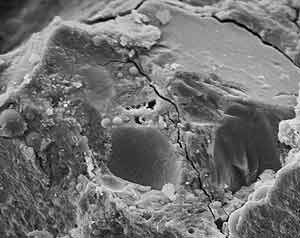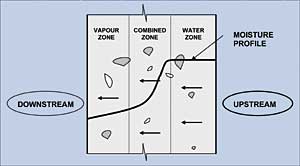Concrete Waterproofing with Crystalline Technology
Despite its apparent density, concrete remains a porous and permeable material that can leak and deteriorate rapidly when in contact with water or the intrusion of aggressive chemicals, such as carbon dioxide, carbon monoxide, chlorides, sulfates or other substances. But there are other ways in which water can be transported through concrete.
|
Vapor Flow and Relative Humidity
Water also migrates in the form of water vapor as relative humidity. Relative humidity is water held in air as a dissolved gas. As water vapor heats up, it contains more water and exerts vapor pressure. Water can also be transported through concrete as vapor. The direction of flow travels from high vapor pressure, generally the source, to low vapor pressure, by a process of diffusion. The direction of flow could vary based on environmental conditions.
The direction of vapor flow is critical when applying waterproofing treatment in situations where an unbalanced vapor pressure gradient exists. Typical examples include:
- Applying a low vapor permeable membrane, such as a traffic deck coating over a damp concrete surface (even if the very top surface is dry) on a warm day will result in pressure vapor pressure build-up and pin-holing or blistering.
- Applying a coating or sealant to the outside of a building wall may trap moisture into the wall if the sealant is not sufficiently vapor permeable.
- Applying low vapor permeable flooring over a slab-on-grade where there is high subsurface moisture content may result in delamination of the flooring.
Generally, a low vapor permeable sealant or coating should not be placed on the downstream face of a building or structure. Either the vapor pressure or water pressure will act to damage and blister the membrane. Some types of coatings and water permeability reducing admixtures in the concrete accommodate considerable vapor movement, thus allowing them to be placed successfully on the downstream side. Primary examples are cement-based waterproof coatings and water permeability reducing admixtures.
|
How Crystalline Waterproofing Technology Works
Crystalline technology improves the durability and performance of concrete structures, lowering their maintenance cost and extending their lifespan by protecting them against the effect of aggressive chemicals. These high performance qualities result from the ways in which the crystalline technology works, when used with concrete.
Crystalline waterproofing technology improves the waterproofing and durability of concrete by filling and plugging pores, capillaries, micro-cracks, and other voids with a non-soluble, highly resistant crystalline formation. The waterproofing effect is based on two simple reactions, one chemical and one physical. Concrete is chemical in nature. When a cement particle hydrates, the reaction between water and the cement causes it to become a hard, solid mass. The reaction also generates chemical by-products that lie dormant in the concrete.
Crystalline waterproofing adds another set of chemicals to the mixture. When these two chemical groups, the by products of cement hydration and the crystalline chemicals, are brought together in the presence of moisture, a chemical reaction occurs. The end product of this reaction is a non soluble crystalline structure.
This crystalline structure can only occur where moisture is present, and thus will form in the pores, capillary tracts, and shrinkage cracks in concrete. Wherever water goes, crystalline waterproofing will form filling the pore, voids and cracks.











